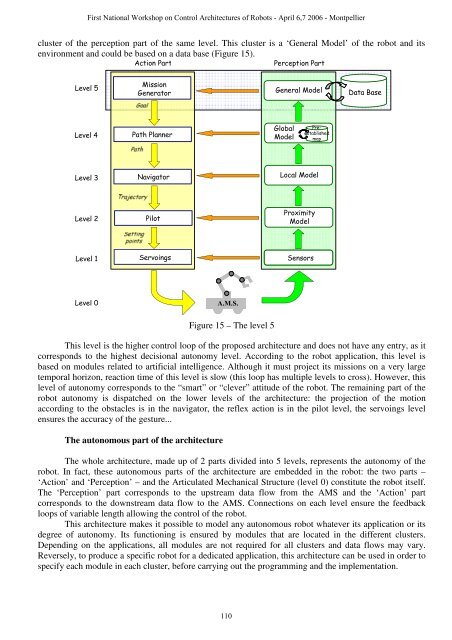Pleading for open modular architectures - Lirmm
Pleading for open modular architectures - Lirmm
Pleading for open modular architectures - Lirmm
You also want an ePaper? Increase the reach of your titles
YUMPU automatically turns print PDFs into web optimized ePapers that Google loves.
cluster of the perception part of the same level. This cluster is a ‘General Model’ of the robot and its<br />
environment and could be based on a data base (Figure 15).<br />
Level 5<br />
Level 4<br />
Level 3<br />
Level 2<br />
Level 1<br />
Level 0<br />
First National Workshop on Control Architectures of Robots - April 6,7 2006 - Montpellier<br />
Action Part Perception Part<br />
Mission<br />
Generator<br />
Path Planner<br />
Navigator<br />
Pilot<br />
Asservissements<br />
Servoings Sensors Capteurs<br />
A.M.S. ROBOT<br />
Figure 15 – The level 5<br />
General Model Data Base<br />
Global<br />
Model<br />
Local Model<br />
Proximity<br />
Model<br />
Preestablished<br />
map<br />
This level is the higher control loop of the proposed architecture and does not have any entry, as it<br />
corresponds to the highest decisional autonomy level. According to the robot application, this level is<br />
based on modules related to artificial intelligence. Although it must project its missions on a very large<br />
temporal horizon, reaction time of this level is slow (this loop has multiple levels to cross). However, this<br />
level of autonomy corresponds to the “smart” or “clever” attitude of the robot. The remaining part of the<br />
robot autonomy is dispatched on the lower levels of the architecture: the projection of the motion<br />
according to the obstacles is in the navigator, the reflex action is in the pilot level, the servoings level<br />
ensures the accuracy of the gesture...<br />
The autonomous part of the architecture<br />
The whole architecture, made up of 2 parts divided into 5 levels, represents the autonomy of the<br />
robot. In fact, these autonomous parts of the architecture are embedded in the robot: the two parts –<br />
‘Action’ and ‘Perception’ – and the Articulated Mechanical Structure (level 0) constitute the robot itself.<br />
The ‘Perception’ part corresponds to the upstream data flow from the AMS and the ‘Action’ part<br />
corresponds to the downstream data flow to the AMS. Connections on each level ensure the feedback<br />
loops of variable length allowing the control of the robot.<br />
This architecture makes it possible to model any autonomous robot whatever its application or its<br />
degree of autonomy. Its functioning is ensured by modules that are located in the different clusters.<br />
Depending on the applications, all modules are not required <strong>for</strong> all clusters and data flows may vary.<br />
Reversely, to produce a specific robot <strong>for</strong> a dedicated application, this architecture can be used in order to<br />
specify each module in each cluster, be<strong>for</strong>e carrying out the programming and the implementation.<br />
110

















